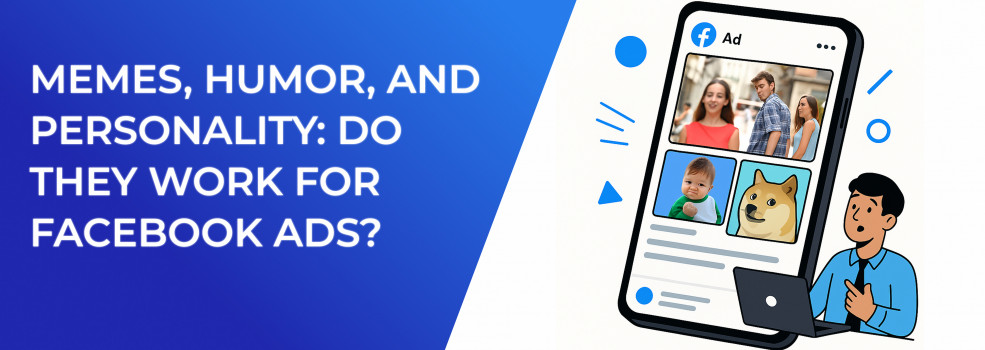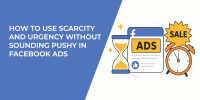If you manage Facebook ad optimization every day, you know the first battle is simply getting users to pause their thumbs. Funny memes, cheeky GIFs, and ads written in a brand-first voice all promise higher ad impressions Facebook and lower CPM; but do they actually improve performance once the giggles fade? To keep your humor punchy and brand-safe, take a quick look at our guide on how to use humor in Facebook ads without losing professionalism.
Below, you’ll find what the data says about humor-led creative, how it affects key Facebook ad metrics, and the steps you can take to keep laughs (and conversions) flowing.
1. Why humor grabs attention but not always conversions
Memes trigger instant recognition dopamine, perfect for boosting Facebook advertising CTR in the auction because Meta’s relevance score rewards ads that earn quick reacts, comments, or shares. Brands that layer personality onto dry offers often see a 10–25% bump in click-through rate Facebook ads, comfortably above the good CTR on Facebook ads benchmark of about 1.8% for most industries.
However, humor alone can depress post-click performance. When the joke is not directly tied to the offer, Facebook ads conversion rate can slide as much as 15%. Test witty hooks, but reserve your strongest punchline for the landing-page headline so the experience feels connected.
2. Match meme style to audience personality
Great jokes bomb when they are told to the wrong room. Before patching a SpongeBob image into your Meta ads campaign, dig into Facebook advertising analytics to segment age, interests, and past engagement.
-
Gen Z and young millennials: rapid-fire meme formats, self-aware humor
-
Professionals 30-45: light irony, relatable workplace jokes
-
50-plus audiences: gentle comedy, nostalgic references
Tailor the joke to the room: age and context change the meme that works.
If you need a refresher on the basics, Facebook Ad Targeting 101: How to Reach the Right Audience walks through core segmentation tactics step by step.
Use those findings to write copy that still hits your primary keyword cluster (for example, “free trial” or “next-day shipping”) so campaign budget optimization algorithms have enough semantic cues.
3. Budget and pacing: Do not let jokes eat your ROAS
Humor can boost top-of-funnel ad impressions Facebook so quickly that you blow through spend caps. Protect margins with the Advantage Campaign Budget setting, Meta’s automated CBO. It reallocates dollars hourly to ad sets that keep average cost per click Facebook within goal.
Pro tip: If you are launching several comedy concepts at once, switch on Facebook ads learning phase insights. When “Learning Limited” appears, merge low-impression sets so the algorithm exits training faster. For a deeper troubleshooting checklist, see How to Finish the Facebook Learning Phase Quickly.
4. Retarget with personality, convert with proof
Memes excel at growing warm audiences. Drop a Facebook retargeting pixel on your site and build a 30-day engaged-viewers segment. New to warm-audience follow-ups? Our tutorial on how to set up Facebook retargeting covers every step, from pixel install to audience rules.
Humor on the front end, case studies on the back end.
That two-step funnel routinely lands a Facebook advertising CPM 12% cheaper than single-shot promos and keeps your average click-through rate on Facebook ads healthy because the creative narrative feels cohesive.
5. Measure what really moved the needle
For extra context on reading performance data, check out How to Analyze Facebook Ad Performance Beyond CTR and CPC.
It is easy to get hypnotized by laughing-face reactions, so let’s zoom out and focus on numbers tied directly to revenue. Before diving into your dashboard, remind yourself that marketing humor is only as good as the money it brings back. The table below highlights the metrics that deserve front-row seats in your weekly review:
Once you routinely track these signals, you can shift budget with confidence, back out of tactics that entertain without paying off, and double down on joke formats that keep cash registers ringing.
6. A/B testing checklist (bookmark this)
Painting memes on top of static offers is fun, but serious testing discipline separates guesswork from repeatable wins. Treat every comedic asset like a science experiment. Follow the sequence below and you will avoid the learning-phase purgatory that traps so many playful ad sets:
-
Isolate one joke at a time – swap only the meme image, keep the headline constant.
-
Run 5–7 days minimum to exit the learning phase.
-
Pause at 95% confidence once a winner emerges.
-
Iterate headline and CTA on the champion ad.
-
Slide budget using CBO to scale without resetting data.
Need more ideas to structure experiments? Key strategies for Facebook ad testing breaks down creative-versus-audience-versus-copy test plans.
Stick to these guardrails and you will cut wasted spend, gather cleaner insights, and build a creative library where every punchline pulls measurable weight.
7. Short answers to the questions clients ask
Even seasoned media buyers get grilled about comedy in ads. Equip yourself with fast, data-backed replies so stakeholders stay excited rather than nervous:
Clients love memes—until they ask about ROI. Be ready with clear, confident answers.
-
Will this really convert?
It can — if the meme or humor is tightly aligned with the product’s value prop and followed by consistent messaging in the funnel. Humor should act as the hook, not the whole pitch. What is a good click-through rate for Facebook ads with memes?
Aim for 2–3%, roughly 30% above the average industry CTR. For current benchmarks, our 2025 study on the average click-through rate for Facebook ads provides fresh industry numbers you can cite to stakeholders.-
Will jokes hurt my CPA?
Only if the landing page drops the comedic tone. Keep personality consistent to maintain Facebook advertising CTR and conversions. -
How many memes are too many?
If comments shift from tagging friends to “What is the product again?”, you have gone too far. Rotate humor with value-centric creative every 7–10 days.
By handling objections head-on, you reinforce strategic trust and keep the door open for future experiments that blend entertainment with ROI.
8. Final take
Humor, memes, and brand personality absolutely can work for Facebook ads when they are architected with the same rigor you apply to bid caps and negative keywords. Treat comedy as a strategic lever in your broader best practices for Facebook ads playbook, not a magic bullet.
Align joke format to audience persona, safeguard budgets with campaign budget optimization, and judge success by down-funnel metrics. Do that, and you will end up with a timeline full of laughs and a report full of profit — something every marketer can smile about.

